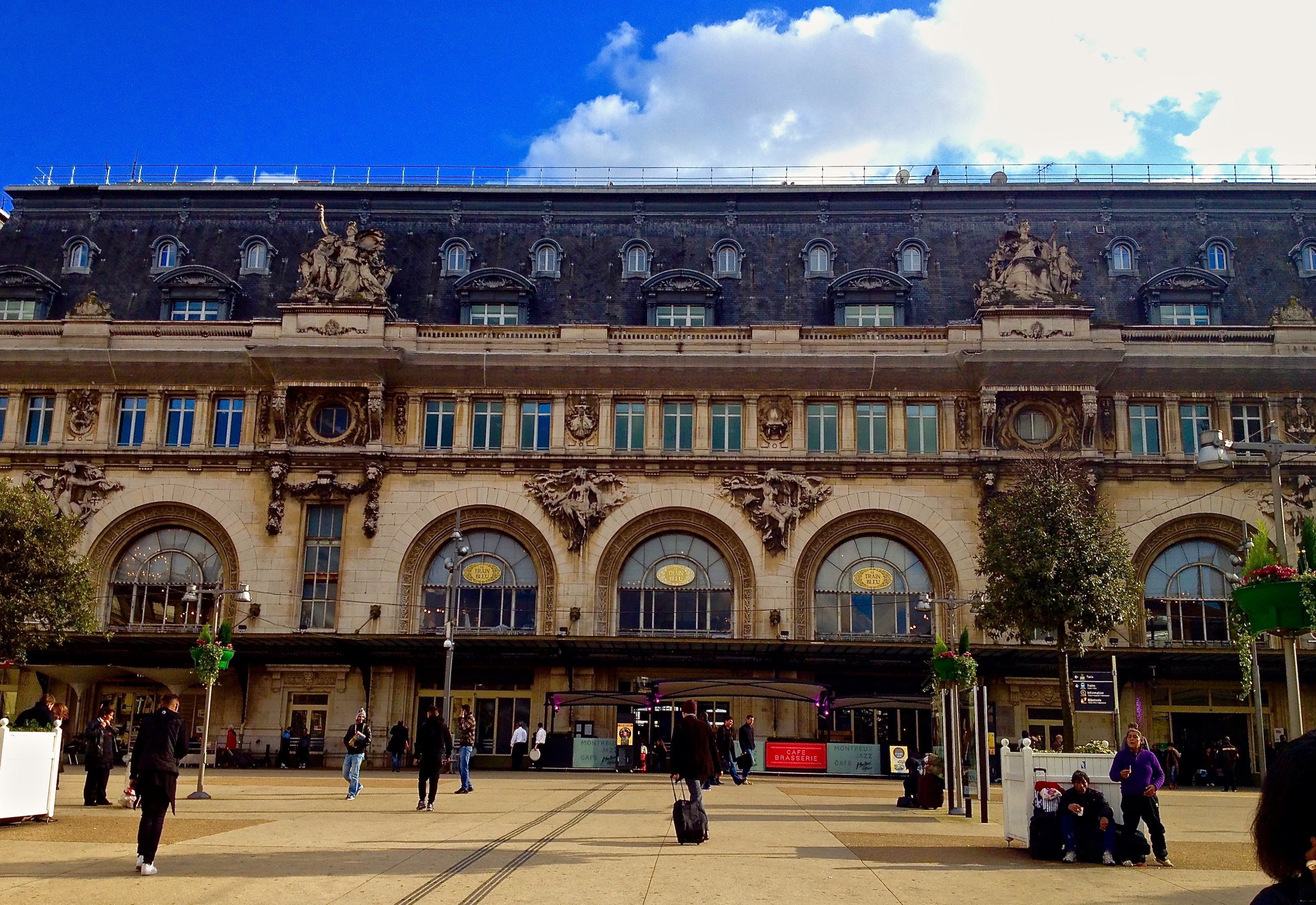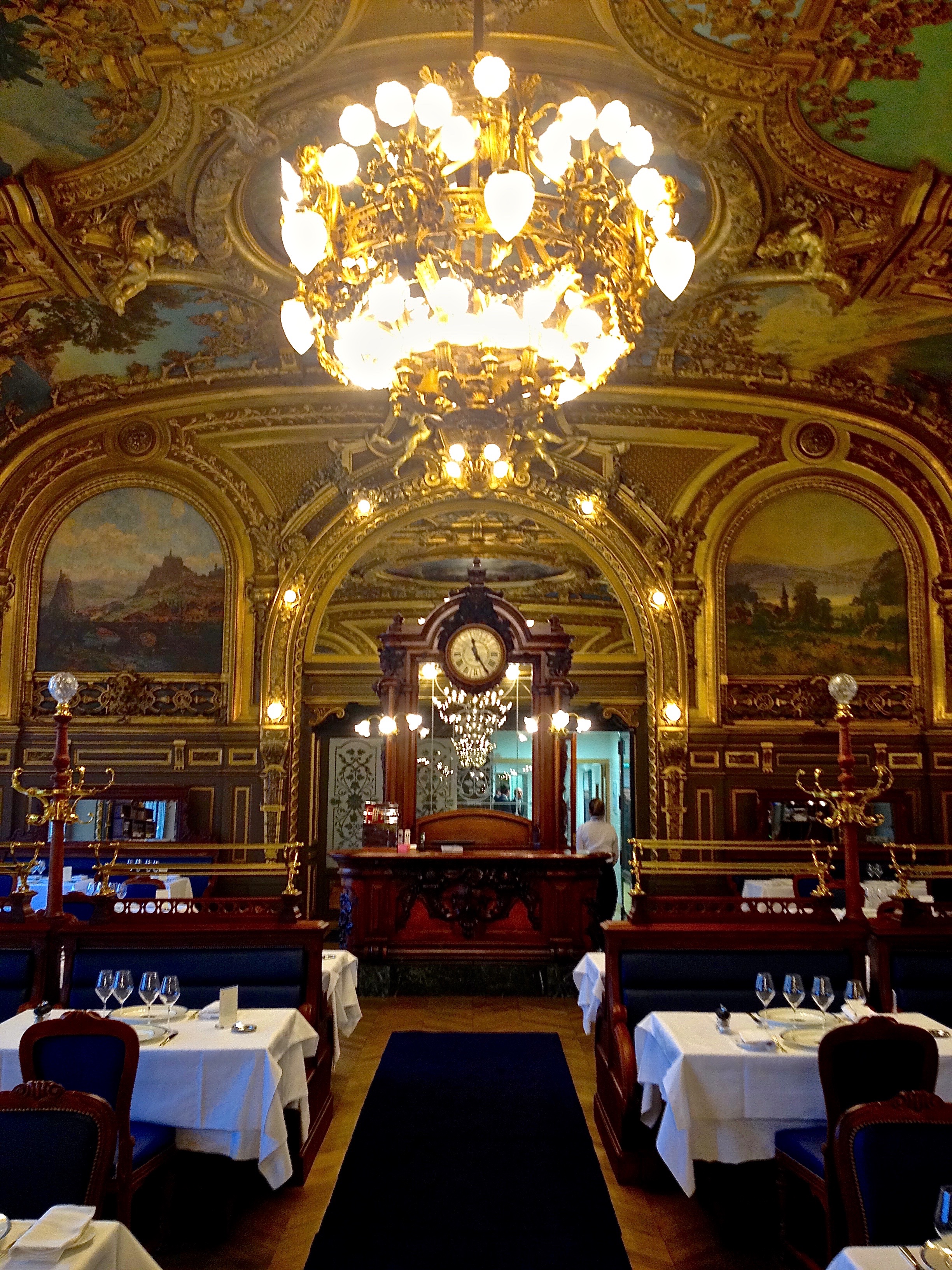Soon after we moved to Paris I sought out this “Place” M.F.K. Fisher wrote eloquently about as being more than just a train depot for entering or exiting the city. She was referring to the Gare de Lyon in the 12th Arrondissement. I wanted to know why it was so special.
Fisher’s experience on French trains began in 1929 when she moved from California to Dijon. She described herself in the early years as “…always one more ant scuttling for a certain track.” Then, in 1937, while waiting for guests to arrive, she sat under the enormous glass roof in a trackside café with marble tables and green trees planted in boxes. With a brandy and water in hand, absorbing her surroundings, she was suddenly overcome by a feeling that she “was not in a station, but in a Place”. From then on, she made it a habit to arrive early–with time to wait.
In the 1960s and early ‘70s, after children and husbands and lovers were long gone, she was often sent to Provence on writing assignments. Her publishers encouraged her to fly south from Paris. Memories honed decades earlier meant she preferred the “Mistral” train from Gare de Lyon to Marseille or Aix-en-Provence.
She developed the habit of arriving at least two hours before departure. This allowed time to ascend the wide stone staircase to the second floor restaurant–Le Train Bleu. When you spin through the revolving wood and glass door, then and now, it is like walking into a time capsule from La Belle Époque. Instinctively, you stand a little taller and walk a little more gracefully to your table.
In 1900, Paris was hosting a second world’s fair. As part of the preparation, a new train station, Gare de Lyon, was designed to highlight the railway lines of the PLM [Paris-Lyon-Marseille] Company from Paris to destinations in Provence and the Côte d’Azur on the Mediterranean. The company also wanted a prestigious and elegant restaurant to symbolize travel, luxury and comfort.

In 1901, Buffet de la Gare de Lyon first opened its’ doors amid sumptuous art nouveau décor. Ornate carvings, moldings, gilding, and imposing chandeliers highlighted frescoes and murals of cities and scenery viewed from PLM trains as they headed south and east. The restaurant offered tranquility, character, and a place for travelers to spend a refined break. In Fisher’s words, it was “all that was opulently cheerful, generously vulgar and delightful about la Belle Époque.”
In 1963, the restaurant was renamed Le Train Bleu in reference to the French Riviera destinations.
Fisher’s early arrival gave her the luxury of time for a leisurely breakfast or lunch. In the 1960s, she believed that the fresh bread served in Le Train Bleu was the best she had tasted since before WWII. For petit déjeuner she always had “bread and butter, Parma ham, and a half-bottle of brut champagne…”, which she thought a bit expensive, but enjoyed all the same.
If lunchtime, she started off with a Kir and wine cocktail, followed by some kind of soufflé and fresh berries for dessert. Oh–and a half bottle of white wine–Grand-Cru Chablis. She liked her grown up drinks, having adapted easily to the French way.
Interestingly, Fisher played a role in the longevity and preservation of Le Train Bleu. By the early 1970s, the paintings were filthy with soot and pollution, gold leaf was flaking from the ceiling, the lace curtains hung in tatters and, underfoot, the flooring creaked and sagged. She was told by a group of worried waiters that the restaurant’s survival seemed doomed. She relayed all this to an American friend, Janet Flanner, who was also her neighbor. Flanner, a longtime journalist and Paris correspondent for the New Yorker magazine, went directly to the French Minister of Culture at the time. Le Train Bleu was designated an historic monument in 1972.
Since that time there have been many renovations, the most recent in 2014. Parquet floors were insulated and shored up, paintings re-cleaned, carved moldings refinished or repainted, brass coat and luggage racks polished, and leather banquettes refurbished. The name over the door was updated from neon lights to a chic metal plate.


The antique Big Ben Bar from 1901 is used today as a decoration piece and stands imposingly by the swinging glass doors to the kitchen. The original cash register is there too.
There is not one corner or wall, ceiling or chandelier, archway or window in this special Place that doesn’t grab your attention or overwhelm your senses. Every time.
These days, the menu is priced for upper-crust travellers, tourists, or well-heeled Parisians. But because it is such a Place, truly unlike any other, it’s always worth it.
Recently, I went for lunch by myself. Timed perfectly, I arrived near the end of the service, around 2:00 PM. On this cool, autumn day I decided to try the made-in-house foie gras served with rhubarb chutney and grainy toast, green salad and a glass of Montrachet white wine–from Burgundy.
When I dine alone, the pleasure is subtle and personal. Not everyone feels this way. But, over time, I have fine-tuned the ability to “disappear” in public and enjoy everything around me as if I were invisibly dropped into the scene. It is an example of cultural learning from which I have benefited greatly.
Fisher sometimes spoke of moving like “a ghost” in her travels, seemingly invisible to others, often because she was wrapped up in one of personal trials. I understand what she meant, but in a different way. For me, invisibility is a feeling of being completely content with my own company. And, at the same time, not taking anything, within the experience I am having, for granted. I observe and wonder, discreetly, without being the center of anyone else’s observations.

On this particular day, directly in front of me was an opulent antique buffet with perfectly arranged wine glasses and the PLM [Paris-Lyon-Marseille] logo carved on the top piece. Above that, reaching up to the very high ceiling, was a colorful painting of Marseille.
As the tables to the left and right gradually emptied, I gazed openly through the window to my left onto the tracks and boarding passengers one floor below. I wondered where they were going, how long they would stay. Was it travel for business, pleasure, something mysterious or even sad?

To the right, down a long banquette of tables reset for another meal, sat two diners leaning in towards one another. They were silhouetted against the window overlooking the square at the entrance. Why were they lingering? What was their conversation? When you are invisible, all possibilities are imagined.

Meal over, espresso finished, with no train to catch, I made my way home. Musing on the métro, my thoughts drifted to a weekend getaway my husband and I took from Paris to Avignon several months before–a trip that began in a place, not a station…
That story here: Paris to Avignon






















Hi Wendy, Alec and I hope to come to Paris a few times this school year. Let’s go to Le Train Bleu!
LikeLike